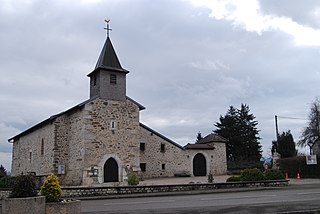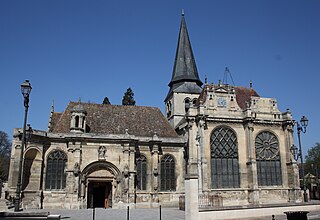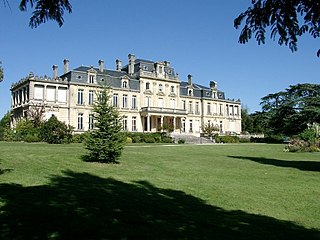
Bourg-la-Reine is a commune in the southern suburbs of Paris, France. It is located 9.1 km (5.7 mi) from the center of Paris.

Saint-Maur-des-Fossés is a commune in Val-de-Marne, the southeastern suburbs of Paris, France, 11.7 kilometres from the centre of Paris.

Ornex is a commune in the Ain department in eastern France.

Châtenay-Malabry is a commune in the southwestern suburbs of Paris. It is located 10.8 km (6.7 mi) from the center of Paris.

Levallois-Perret is a commune in the Hauts-de-Seine department and Île-de-France region of north-central France. It lies on the right bank of the Seine, some 6 km (3.7 mi) from the centre of Paris in the north-western suburbs of the French capital. It is the most densely populated town in Europe and, together with neighbouring Neuilly-sur-Seine, one of the most expensive suburbs of Paris.

Jean-Pierre Claris de Florian was a French poet, novelist and fabulist.

Pessac is a commune in the Gironde department in Nouvelle-Aquitaine in southwestern France. It is a member of the metropolis of Bordeaux, being the second-largest suburb of Bordeaux and located just southwest of it. Pessac is also home to Bordeaux Montaigne University and the Institut d'études politiques de Bordeaux.

The arrondissement of Gex is an arrondissement of France in the Ain department in the Auvergne-Rhône-Alpes region. It approximately corresponds to the historical region of the Pays de Gex. It has 27 communes. Its population is 93,027 (2016), and its area is 404.9 km2 (156.3 sq mi).

La Celle-Saint-Cloud is a commune in the Yvelines department in the Île-de-France region in Northern France. It is a western outer suburb of Paris, 15.6 km (9.7 mi) from its centre, on the departmental border with Hauts-de-Seine. In 2021, it had a population of 20,476.

Magny-en-Vexin is a commune in the Val-d'Oise département in Île-de-France in northern France. It is located in the regional nature park of Vexin.

Saint-Genis-Pouilly is a commune in the Ain department within the Auvergne-Rhône-Alpes region of eastern France.

Prévessin-Moëns is a commune in the Ain department in eastern France, in the region of Auvergne-Rhône-Alpes.

Ségny, also written Segny, is a commune in the Ain department in eastern France.
The canton of Ferney-Voltaire is a former administrative division in eastern France. It was disbanded following the French canton reorganisation which came into effect in March 2015. It had 40,677 inhabitants (2012).

Mérignac is a commune in the Gironde department in Nouvelle-Aquitaine in southwestern France. The 20th-century historian Robert Étienne (1921–2009) was born in Mérignac.

The canton of Saint-Genis-Pouilly is an administrative division of the Ain department, in eastern France. It was created at the French canton reorganisation which came into effect in March 2015. Its seat is in Saint-Genis-Pouilly.
Lycée international de Ferney-Voltaire is a public secondary school in Ferney-Voltaire, Ain, Auvergne-Rhône-Alpes, France. The school serves junior high school (collège) and senior high school/sixth form college (lycée) students. It has a branch campus in Saint-Genis-Pouilly.

The Château de Voltaire is located in Ferney-Voltaire (Ain) in France, close to the border with Switzerland and the city of Geneva. It was Voltaire’s home between 1761 and 1778. It was listed as a historical monument in 1958 and acquired by the French State in 1999.

Richard Forster is a Swiss photographer and mechanical engineer. He is best known for nude photography in natural environments. His consistency and perseverance produced an opus which brought him recognition beyond Switzerland and France.
Communauté d'agglomération du Pays de Gex is the communauté d'agglomération, an intercommunal structure, centred on the town of Gex. It is located in the Ain department, in the Auvergne-Rhône-Alpes region, eastern France. Created in 1995, the administrative seat is located in its namesake commune of Gex. Its area is 404.9 km2. Its population was 98,257 in 2019, of which 13,121 lived in Gex proper.
























